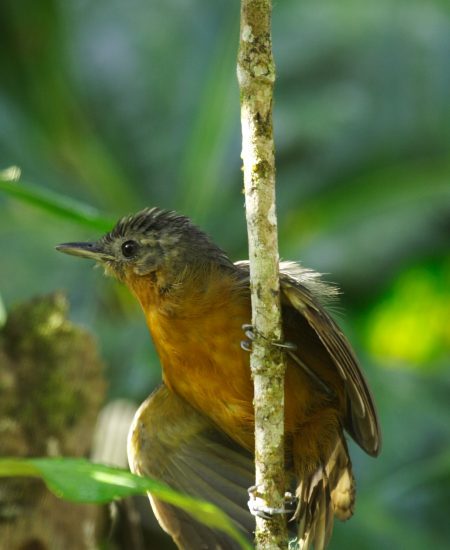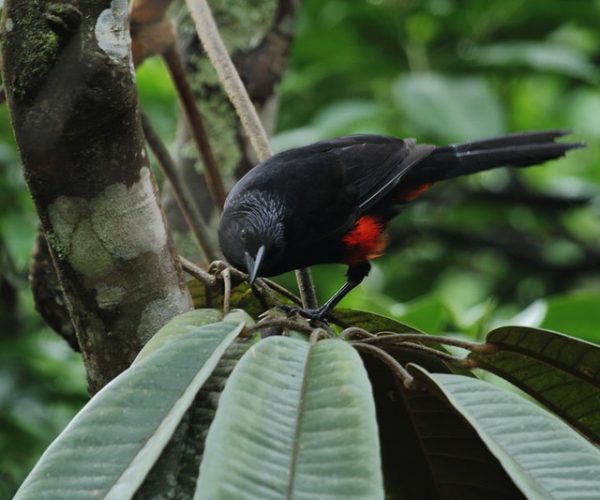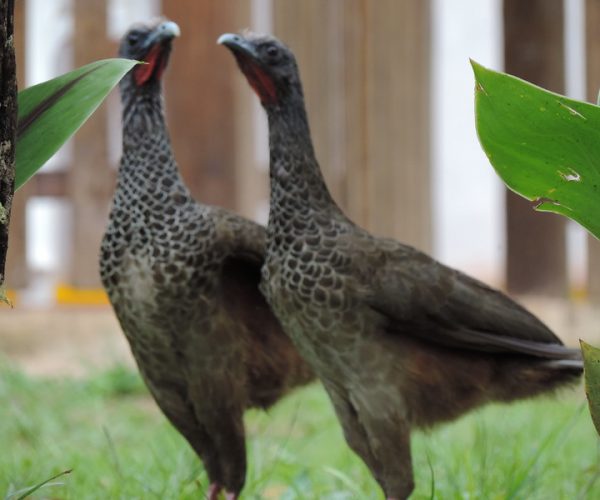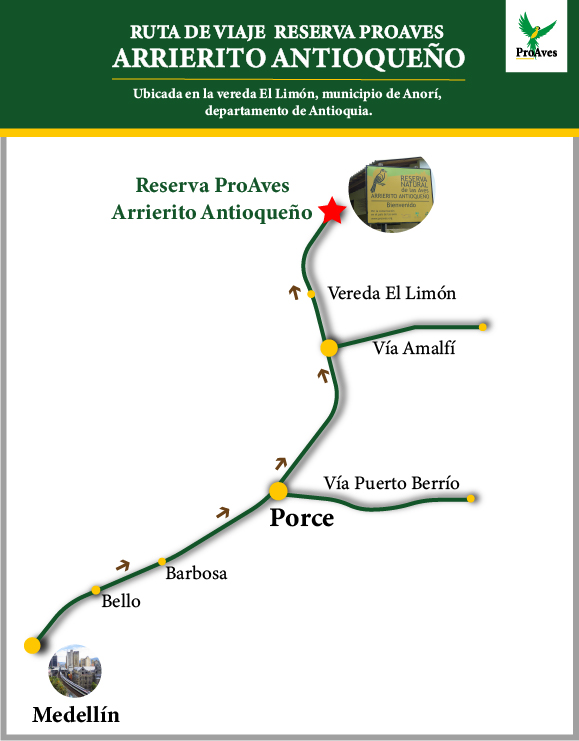Home of the majestic Chestnut-capped Piha
The Reserve has a colonial farmhouse that provides accommodation in eight rooms, with comfortable beds and private bathrooms. Ours fees include full board, conservation fee, good trails with easy to moderate conditions and excellent birding. The Chestnut-capped Piha now survives only in small forest fragments in the Central Cordillera of the Andes because their habitat was much affected in the early twentieth century by gold mining and later by large-scale deforestation for the establishment of pasture the reserve is of great importance to its care. Visit us!
- Altitudinal range: Between 1,400 and 1,850 AMSL
- Weather: 64,4 °F, Pre-montane humid forest, Bimodal
Location
The Arrierito Antioqueño ProAves Reserve is located in the village of El Limón, municipality of Anorí, department of Antioquia, 148 kilometers north of the city of Medellín.
How to get to Arrierito Antioqueño
- Public transportation:
Take a COONORTE bus to Anorí from the Terminal de Transporte del Norte in Medellín.
The Nature Reserve is located 18 km before the town of Anorí, so you should get off before reaching the town.
Estimated time: Approximately 4 hours.
- Private transportation: Any vehicle is suitable for transportation to the Nature Reserve.
- Route: Medellín – Bello – Barbosa – Porce – Vereda El Limón– Arrierito Antioqueño ProAves Reserve.
OUR LODGE
The Reserve has accommodation for 8 people with comfortable cabins, with private bathrooms, electricity, drinking and hot water:

Amenities and services
Visitors will enjoy:
- Internet access, when is possible
- Water, coffee and tea station
- Bird watching of endemic bird species, feeders as well as different species of mammals and wildlife in general
- Enjoy trails, terraces, and seating areas
- Comfortable rooms
The reservation does not include food or transportation. Any extra service must be requested at the reception and has an additional cost.
THINGS TO DO

Bird and wildlife watching

Take an excursion through the internal trails

Nighttime wildlife observation: mammals, spiders and more

Meet the Chestnut-capped Piha along the trails

Explore the garden and its wonderful species of fauna and flora

Observe the hummingbirds in the feeders
- We recommend a minimum stay of 2- 3 nights to enjoy the activities and variety of wildlife.
TRAVEL TIPS
FOLLOW THESE RECOMMENDATIONS AND ENJOY YOUR STAY:
- RESERVATION
Make your reservation 24 hours in advance. Walk-in reservations are not guaranteed and are dependent on current availability.
- CHECK IN AND CHECK OUT
The ProAves Reserve opens at 6:00 a.m. and closes at 8:00 p.m. Time of entry to your room: From 3:00 p.m. and time of departure from your room: Maximum at 10:00 a.m.
- RESERVATION POLICIES
You can change the dates of the reservation, as long as there is availability. Changes must be requested in writing and 15 days in advance. No refund is made for cancellation.
- MEALS
Inform us of any health problems, allergies, or food requirements. We will offer you a special menu according to your diet.
- DO NOT COLLECT
Please, respect the natural resources of the Nature Reserve. The collection of any biological material is not allowed.
- TRANSPORT
Any vehicle is suitable for transportation to the Nature Reserve.
- CLOTHING
Remember that the climate in Colombia can be very unpredictable! We recommend you bring suitable walking shoes, a rain jacket, long-sleeved clothing, a sun hat, and sunscreen.
- FLASHLIGHT
In the Natural Reserve there may be power outages, so bring a flashlight and enjoy connecting with nature without the distraction of modern technology.
- MOSQUITOES
You do not need a yellow fever vaccine. However, we recommend using repellent since being in contact with nature there may be mosquitoes.
- FORBIDDEN TO ENTER ALCOHOL
The entry of alcoholic beverages into the Nature Reserve is forbidden.
- INTERNAL TRAILS
Follow the instructions of the Nature Reserve staff and stay on the established trails.
Arrierito Antioqueño
SUSTAINABILITY & CONSERVATION
The Arrierito Antioqueño ProAves Reserve was created on 27 November 2006, to protect the habitat of Chestnut-capped Piha (Lipaugus weberi). It has an area of approximately 3.271 acres and is classified according to the Alliance for Zero Extinction as an AZE site.
Consists of primary forests, secondary forests, and grasslands undergoing some regeneration. Its predominantly mountainous, about 60% of the land with slopes, 30% hills, and 10% flat.
As for frogs, there are seven vulnerable species, four endangered and five that have not yet been formally identified; it is believed that at least one of them belongs to one of the most threatened groups of frogs, the genus Atelopus, which lives only in this region.
You can spot the Black Tinamou (Tinamus osgoodi), Sharpbill (Oxyruncus cristatus), the Stiles’s Tapaculo (Scytalopus Stilesi), the Parker’s Antbird (Cercomacra parkeri), the Bicoloured Hawk (Accipiter bicolor), the Red-bellied Grackle (Hypopyrrhus pyrohypogaster) Multicolored Tanager (Chlorochrysa nitidísima), the Black-and-gold Tanager (Bangsia melanochlamys) and Cerulean Warbler (Dendroica cerulea), a migratory species that visit the reserve in non-breeding season.

